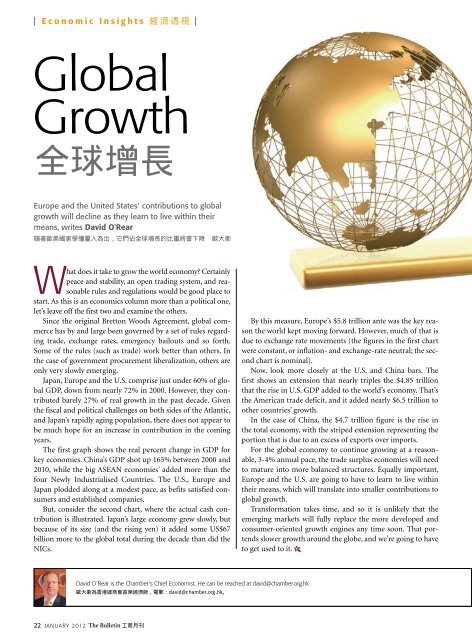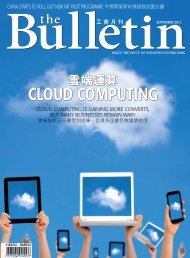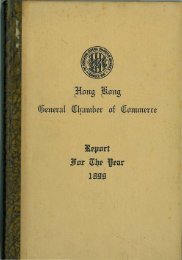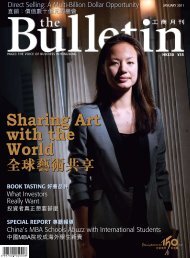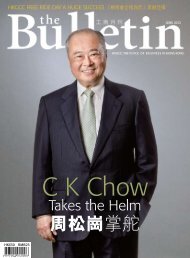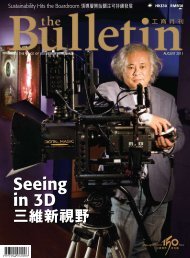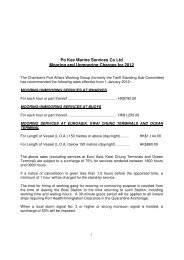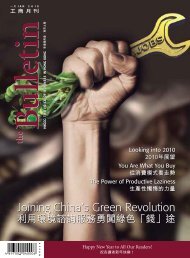å ¨çä¿¡è³´åèªå¯ - The Hong Kong General Chamber of Commerce
å ¨çä¿¡è³´åèªå¯ - The Hong Kong General Chamber of Commerce
å ¨çä¿¡è³´åèªå¯ - The Hong Kong General Chamber of Commerce
- No tags were found...
You also want an ePaper? Increase the reach of your titles
YUMPU automatically turns print PDFs into web optimized ePapers that Google loves.
| Economic Insights 經 濟 透 視 |GlobalGrowth全 球 增 長Europe and the United States’ contributions to globalgrowth will decline as they learn to live within theirmeans, writes David O'Rear隨 著 歐 美 國 家 學 懂 量 入 為 出 , 它 們 佔 全 球 增 長 的 比 重 將 會 下 降歐 大 衛What does it take to grow the world economy? Certainlypeace and stability, an open trading system, and reasonablerules and regulations would be good place tostart. As this is an economics column more than a political one,let’s leave <strong>of</strong>f the first two and examine the others.Since the original Bretton Woods Agreement, global commercehas by and large been governed by a set <strong>of</strong> rules regardingtrade, exchange rates, emergency bailouts and so forth.Some <strong>of</strong> the rules (such as trade) work better than others. Inthe case <strong>of</strong> government procurement liberalization, others areonly very slowly emerging.Japan, Europe and the U.S. comprise just under 60% <strong>of</strong> globalGDP, down from nearly 72% in 2000. However, they contributedbarely 27% <strong>of</strong> real growth in the past decade. Giventhe fiscal and political challenges on both sides <strong>of</strong> the Atlantic,and Japan’s rapidly aging population, there does not appear tobe much hope for an increase in contribution in the comingyears.<strong>The</strong> first graph shows the real percent change in GDP forkey economies. China’s GDP shot up 165% between 2000 and2010, while the big ASEAN economies’ added more than thefour Newly Industrialised Countries. <strong>The</strong> U.S., Europe andJapan plodded along at a modest pace, as befits satisfied consumersand established companies.But, consider the second chart, where the actual cash contributionis illustrated. Japan’s large economy grew slowly, butbecause <strong>of</strong> its size (and the rising yen) it added some US$67billion more to the global total during the decade than did theNICs.By this measure, Europe’s $5.8 trillion ante was the key reasonthe world kept moving forward. However, much <strong>of</strong> that isdue to exchange rate movements (the figures in the first chartwere constant, or inflation- and exchange-rate neutral; the secondchart is nominal).Now, look more closely at the U.S. and China bars. <strong>The</strong>first shows an extension that nearly triples the $4.85 trillionthat the rise in U.S. GDP added to the world’s economy. That’sthe American trade deficit, and it added nearly $6.5 trillion toother countries’ growth.In the case <strong>of</strong> China, the $4.7 trillion figure is the rise inthe total economy, with the striped extension representing theportion that is due to an excess <strong>of</strong> exports over imports.For the global economy to continue growing at a reasonable,3-4% annual pace, the trade surplus economies will needto mature into more balanced structures. Equally important,Europe and the U.S. are going to have to learn to live withintheir means, which will translate into smaller contributions toglobal growth.Transformation takes time, and so it is unlikely that theemerging markets will fully replace the more developed andconsumer-oriented growth engines any time soon. That portendsslower growth around the globe, and we’re going to haveto get used to it.David O’Rear is the <strong>Chamber</strong>’s Chief Economist. He can be reached at david@chamber.org.hk歐 大 衛 為 香 港 總 商 會 首 席 經 濟 師 , 電 郵 :david@chamber.org.hk。22 January 2012 <strong>The</strong> Bulletin 工 商 月 刊


